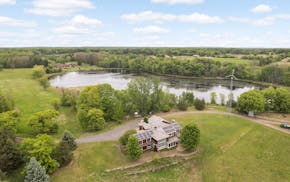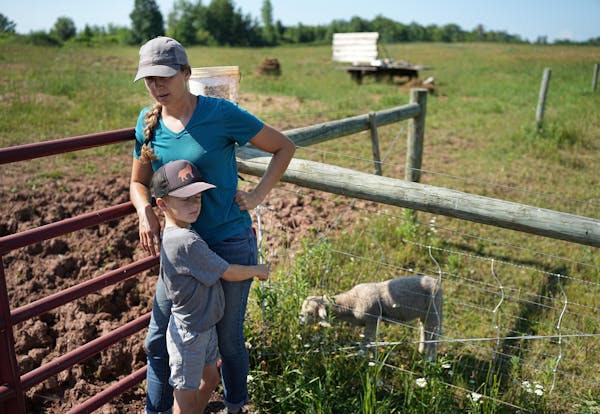NORTH BRANCH, MINN. – Farmer John Peterson sits in his shed, surrounded by snowmobile racing trophies and an antique plow.
Tall, mustachioed and sometimes sharp-tongued, this central Minnesota grower doesn't believe in climate change. He doesn't think much of the government, either. But he's practicing just about one of the most important farming techniques that some climate experts say could help the environment: no-till.
Except he uses a different name.
"What I call it is 'farming ugly,' " Peterson said last month at his Chisago County farm. "You see last year's residue and no life until the 4th of July almost."
But by midsummer, in Peterson's analysis, his corn crop is "kicking [butt]."
Fads come and go in agricultural circles, but popping up with greater frequency across farm retail stores and in rural route mailboxes are offers for farmers to enroll fields into carbon capture programs — sometimes dangling tantalizing payouts for carbon stored in a corn or soybean field by use of sustainable practices.
According to the Environmental Protection Agency, U.S. agriculture emits roughly 11% of the nation's greenhouse gases that lead to climate change. With the industry under public pressure to decrease pollution, carbon payments offer a roadmap for realizing lower emissions.
Long a no-till advocate, Peterson recently tried out cover cropping — a farming technique of planting alternative crops, like clover or alfalfa, between a field's corn or soybean rotations. Last fall, he planted rye after enrolling his fields with RegenConnect, a carbon sequestration program grain and food giant Cargill established in 2021.
Like many, Cargill pays farmers who adopt new practices, such as no-tilling or cover-cropping, on a per-tonnage basis of stored carbon. In theory, these programs — called "insets" — diminish a supply chain's carbon footprint.
Others, such as "offsets," enable farmers who are capturing more carbon to sell credits to outside entities, such as a tech firm seeking a clean ESG report.
But many growers try out these new farming techniques with a degree of suspicion.
Reclining in his chair, Peterson estimates he'll need five years to recover revenue lost on this year's experiment with cover crops — rye that he planted in the fall to cover the ground and keep the soil's carbon from escaping — which should lessen his (and Cargill's) carbon footprint.
But his corn's growth has been disappointing this summer, Peterson said, though that's more likely due to "the drought than the cover crop." It's an unfortunate confluence of factors with the drought partly souring his experimentation with the winter crop, which is killed off in the spring. What's left over can compete with the corn for moisture. "It's kind of a double whammy."
From the first of May until the third week of June, he'd only received a few measly tenths of inches of rain moistening his soil, with his corn crop rising roughly to a small adult's calf.
As he walks across a field a few miles off the St. Croix River, where he has farmed for four decades, Peterson notes Cargill's payment of $35 a ton of sequestered carbon won't make him rich. But, he said, at least it would prevent a loss.
"It's not all about how much you're getting paid [by Cargill]. It's a little extra gravy on the potatoes," said Peterson. "But this year's practice of cover crop, I am not getting enough return to even come close to breaking even on my expense of doing it."
He's not alone. While carbon sequestration programs may generate long-term gains, the current year of drought in Minnesota — with 70% of the state reporting "moderate drought" or worse, according to last week's national monitor report — has left some producers feeling underwhelmed by low heights of row crops.
The lightning-quick expansion of such programs has drawn attention from regulators. A January pamphlet prepared by the Minnesota Department of Agriculture (MDA) with the Minnesota Farmers Union and the Farmers' Legal Action Group in St. Paul warned of "the wild west" and urged farmers to read contracts carefully. This spring, legislators passed a prohibition on nondisclosure agreements embedded into carbon storage contracts.
Just last week, the U.S. Department of Agriculture announced $300 million that will help further refine the carbon-saving measurements of regenerative agriculture practices, erecting a national standard akin to organic certification the USDA implemented two decades ago.
"What we know is, while there is a tremendous need, there also needs to be a referee," said Brad Redlin, who manages water quality and soil health programs for the MDA. "I've never seen one that's advising or rewarding poor or damaging practices."
Companies pay Minnesota farmers for carbon
Across the St. Croix River in River Falls, Wis., in Land O' Lakes' research fields, Heather Matthees stood last month in a soil pit up to her neck, holding a shovel. She described what the lack of rainfall has meant for crop growth as she uses a spray bottle to wet down the clay wall.
"When we don't have a lot of rainfall and moisture, it's really difficult to break that [soil] up," said Matthees, who holds a Ph.D. in soil science and is a senior data analyst with WinField United, the agronomy arm of the Arden Hills-based dairy cooperative.
Still, she said, this doesn't mean farmers are backing down. In fact, most are getting in.
Companies are betting on the carbon markets outlasting short-term weather woes for a country driving toward zero emissions — including in agriculture — by midcentury. As of this summer, nearly a dozen buyers offer contracts to Minnesota farmers and the number of enrolled acres is growing.
A nonprofit carbon capture pilot program funded by a range of groups, including General Mills and the Nature Conservancy, grew from 10,000 participating acres in Minnesota to 45,000 enrolled acres this spring.
Last year, Land O' Lakes' Truterra division paid out more than $5 million to nearly 300 farmers for storing over 260,000 tons of carbon.
Indigo, a Boston-based entity, works with nearly 250 farmers in Minnesota, selling credits for at least $40 for every ton of C02 sequestered to companies such as Blue Bottle Coffee and JPMorgan Chase, with farmers keeping 75% of the revenue.
But farmers carry memories of past carbon sequestration flops. In 2010, a carbon market in Chicago folded after seven years due to lack of trading interest. Other critics worry carbon offset programs will allow polluters to continue emitting high volumes of greenhouse gases by simply buying up credits from a corn farm using shaky science to determine carbon sinks.
In mid-June, on a day when U.S. Sen. Tina Smith, toured a dairy operation east of Kenyon, Minn., farmer Donna Lexvold said her dairy cooperative, First District Association, had asked her and her husband, Wayne, to fill out a form noting what carbon practices they entailed.
But as Donna walked through the barns, she wondered just what the worksheet's calculation revealed about her operation.
"What does .956 mean?" Lexvold said, referring to a carbon score. "That number doesn't mean anything to me."
Smith, D-Minn., said carbon sequestration could potentially be a good deal for farmers, but that "it's got to work."
"Many of the producers I've talked to are just feeling like they're not exactly sure what this market is, how the prices get set, and how they're going to be compensated," Smith said.
The history of carbon markets in farming traces back decades. Today, companies use soil samples but also digital satellite images of fields every couple of days.
In general, the companies aim for measuring permanence and additionality — in other words, carbon stored for long periods of time through practices that wouldn't have been employed without enrollment in a program.
Researchers debate carbon storage depths
But academic disputes about the science of carbon sequestration remain. For many years, studies suggested cover-cropping and no-till could boost carbon stores in the shallowest 6 to 8 inches of topsoil.
Researcher Randy Jackson, a professor of grassland ecology at the University of Wisconsin-Madison, has participated in studies that cast doubt on carbon stored at deeper levels.
"I think this depth issue is huge," Jackson said earlier this month. "Most of these studies are only looking in the surface, say 15 centimeters of soil. And I have no doubt they're seeing accumulation of carbon. But go a meter deep, to bedrock. And the deeper soils are losing carbon."
Another scientist, Bill Parton, an emeritus professor in the Department of Forest Rangeland and Watershed Stewardship at Colorado State University, said — like the depths of the ocean — not much is known about deeper soils.
"I really think the data we see in the shallower layers is much more reliable," Parton said.
Regardless, ecologists and carbon market advocates agree that regenerative practices pay dividends for soil health, water quality and erosion prevention. The goal, right now, is simply getting more farmers to enroll.
On Peterson's farm, he calls last year's residue of crops sitting atop his field "trash." As he walked his dry field, he fussed with the leftover stalks of corn.
Peterson speaks agnostically about global warming, but he's been practicing no-till for 20 years, and he doesn't plan on abandoning that practice — even if he doesn't come back to cover crops.
"I just got sick of watching that much soil wash away," Peterson said.
One of the soil's key indicator for health is wriggling earthworms, he said.
"When it rains, my road's covered with earthworms — covered with earthworms," Peterson said. "When there's just a few [earthworms] down there. It's that much different."
Now he's just eager for the next soaking.

Minnesota Department of Health rescinds health worker layoffs

Eco-friendly house on 30 acres near Marine on St. Croix listed at $1.6M

DOGE cuts federal money for upgrades at Velveeta plant in New Ulm

